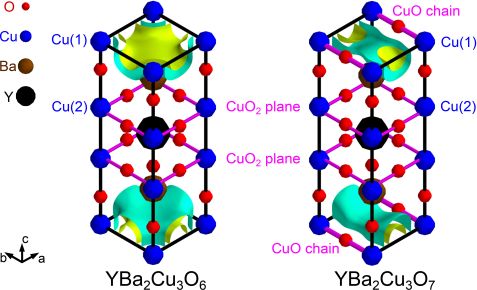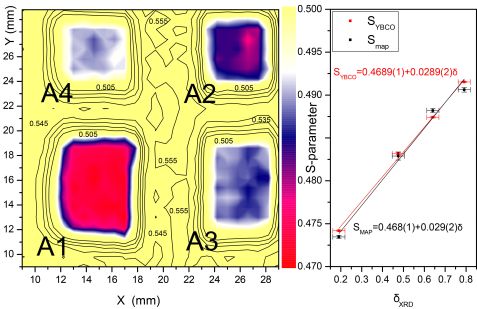MLZ ist eine Kooperation aus:
 > Technische Universität München
> Technische Universität München > Helmholtz-Zentrum Hereon
> Helmholtz-Zentrum Hereon
 > Forschungszentrum Jülich
> Forschungszentrum Jülich
MLZ ist Mitglied in:
 > LENS
> LENS > ERF-AISBL
> ERF-AISBL
MLZ in den sozialen Medien:

MLZ
Lichtenbergstr.1
85748 Garching
Detection and imaging of the oxygen deficiency in single crystalline YBa2Cu3O7−δ films using NEPOMUC
M. Reiner1, T. Gigl1, R. Jany2, G. Hammerl2, C. Hugenschmidt1
1Heinz Maier-Leibnitz Zentrum (MLZ) and Physik-Department E21, Technische Universität München, Garching, Germany
2Experimental Physics VI, Center for Electronic Correlations and Magnetism, University of Augsburg, Augsburg, Germany
In YBa2Cu3O7−δ (YBCO), a variety of exciting phenomena such as high-temperature superconductivity or charge-density wave (CDW) order occurs for certain oxygen deficiencies δ. We have established a linear correlation between the Doppler broadening of the positron-electron annihilation line and δ, as determined by X-ray diffraction (XRD). Our ab-initio calculations reveal the microscopic behavior of the positrons in YBCO crystals as the origin of this dependency. This correlation allows us to use the NEPOMUC positron beam as a sensitive tool for the determination of δ and its spatial fluctuation in YBCO. For a set of laser-deposited single-crystalline YBCO films, we have shown that standard preparation procedures for increasing δ lead to a higher lateral variation and demonstrated the huge potential of positrons for probing the oxygen distribution in YBCO films.
Defect spectroscopy using positrons
Positron Annihilation Spectroscopy (PAS) uses the positron as a probe particle. Positrons in YBCO annihilate rapidly with surrounding electrons after a characteristic lifetime of about 200 ps. Prior to their annihilation, positrons are efficiently trapped in vacancies and other potentially present open volume defects. The trapping in defects is observed by analyzing experimental observables such as the positron lifetime or the Doppler broadening of the electron-positron annihilation line at the characteristic energy of Eγ = 511 keV. The Doppler broadening is reduced if the overlap of the positron wavefunction with high-momentum core electrons becomes smaller, as it is the case in open volume defects. This leads to an increase in the so-called S-parameter, which is a commonly evaluated lineshape parameter sensitive to the number of counts in the central area of the annihilation line. Doppler Broadening Spectroscopy (DBS) at a high lateral resolution of up to 0.3 mm (FWHM) and with short measurement times of only one minute per spectrum can be performed at the CDB-spectrometer at NEPOMUC [1].
High-quality YBCO films

Figure 1: Isosurfaces of the positron density in YBa2Cu3O6 and YBa2Cu3O7. Positrons occupy a delocalized state in the basal plane with its varying oxygen content.
High-quality crystals of YBCO are required in technical devices such as superconducting wires, fault current limiters or magnets and for studying the interplay between CDW and superconducting phases [2,3]. A well-defined value of δ and a homogeneous distribution of the oxygen in the films are highly important for applications and fundamental research. The investigated set of carefully grown high-quality YBCO films of 200 nm thickness was prepared at Universität Augsburg [4]. YBCO was deposited onto SrTiO3 substrates by pulsed laser deposition, which enables growth of single-crystalline layers. In the as-deposited state, δ is around 0.2 as determined by the evaluation of the c-axis lattice parameter from XRD. Subsequent heat treatment at 400 °C after deposition leads to oxygen diffusing out and, hence, allows an increase in δ. Our sample set covered a wide range of 0.191 < δ < 0.791 corresponding to 91 K > Tc > 24 K.
Positrons and oxygen deficiency in YBCO

Figure 2 (as published in [6]): Left: S-parameter map of the four investigated YBCO films fixed on an Al sample holder. Right: Correlation between the characteristic S-parameters SYBCO (determined from depth dependent measurements) and Smap (determined from the map on the left) as a function of the oxygen deficiency δ. The solid lines were obtained by linear fits yielding the given equations.
In order to investigate the behavior of positrons in YBCO, calculations were performed using the MIKA Doppler software package [5]. Crystals with δ = 0 and δ = 1 were modeled. In the first case, the basal plane is completely oxygen deficient whereas, in oxygen rich samples, the additional atoms form CuO chains in the basal plane along the b-axis. The Schrödinger equation for positrons was solved in both cases. As illustrated in Fig. 1, positrons occupy a delocalized state in the basal plane of the unit cells with varying oxygen content. The reason for this is the large amount of open volume in the vicinity of this plane. The localization of positrons at these planes leads to a strong correlation of PAS observables to δ. The Doppler broadening of the annihilation line decreases with the oxygen content, i.e. S(δ) increases with higher δ. Our findings indicate that even when positrons are trapped in Cu or Ba vacancies, PAS observables are still sensitive to changes in the oxygen content in the basal plane [5], making PAS an excellent technique for probing δ.
Several experimental approaches can be chosen in order to investigate the YBCO films by DBS at the NEPOMUC positron beam. Depth profiling, i.e. increasing the incident positron energy from 0.5 to 30 keV, allows depth dependent measurements and an adjustment of the incident energy for further experiments. At an energy of 4 keV, the bulk of the YBCO films is probed whereas, at 7 keV, information at the interface to the substrate is obtained. Throughout the whole depth of the layers, a strong correlation between the S-parameter and δ was found. Characteristic S-parameters for the samples with different δ were derived by averaging the results of depth dependent measurements (see SYBCO in Fig. 2). The correlation is well described by a linear fit. Due to the high lateral resolution available at NEPOMUC, the beam can be scanned over the samples, allowing the S-parameter map shown in Fig. 2 to be recorded. For each of the samples, a characteristic S-parameter Smap can be extracted by averaging the results of spatially resolved DBS. The correlation between Smap and δ is also linear and was used to investigate the lateral variation of δ. A quantitative evaluation [6,7] showed that in the as-deposited sample A1, the lateral variation of S is mainly caused by the statistical error of the measurement and thus, δ is absolutely homogeneous. In the tempered films, δ is higher and shows a larger lateral variation. The latter increases by a factor of around two for the films tempered in vacuum (i. e. A3 and A4) and by a factor of four for the film tempered in a 400 mbar O2-atmosphere (A2).
Implications and future experiments
Our results strongly suggest that low residual pressures should be applied during the heat treatment of YBCO films in order to ensure a homogeneous oxygen distribution in the films. In future, we will use the correlation found between the DBS results and δ to observe the oxygen diffusion in-situ at elevated temperatures. In so doing, we will benefit from the unique experimental prospects of NEPOMUC, namely depth dependent DBS measurements within extremely short times in a wide temperature range between -250 and 900 °C.
Acknowledgments
The authors gratefully acknowledge financial support from the projects BMBF 05K13WO1 and DFG TRR 80.
References:
[1] M. Reiner et al., J. Phys. Conf. Proc. 443, 012071 (2013).
[2] M. K. Wu et al., Phys. Rev. Lett. 58, 908 (1987).
[3] J. Chang et al., Nat. Phys. 8, 871 (2012).
[4] G. Hammerl et al., Nature 407, 162 (2000).
[5] T. Torsti et al., Phys. Status Solidi B-Basic Solid State Phys. 243, 1016 (2006).
[6] M. Reiner, PhD Thesis, Technische Universität München (2015).
[7] M. Reiner et al., Appl. Phys. Lett. 106, 111910 (2015).
MLZ ist eine Kooperation aus:
 > Technische Universität München
> Technische Universität München > Helmholtz-Zentrum Hereon
> Helmholtz-Zentrum Hereon
 > Forschungszentrum Jülich
> Forschungszentrum Jülich
MLZ ist Mitglied in:
 > LENS
> LENS > ERF-AISBL
> ERF-AISBL
MLZ in den sozialen Medien:


